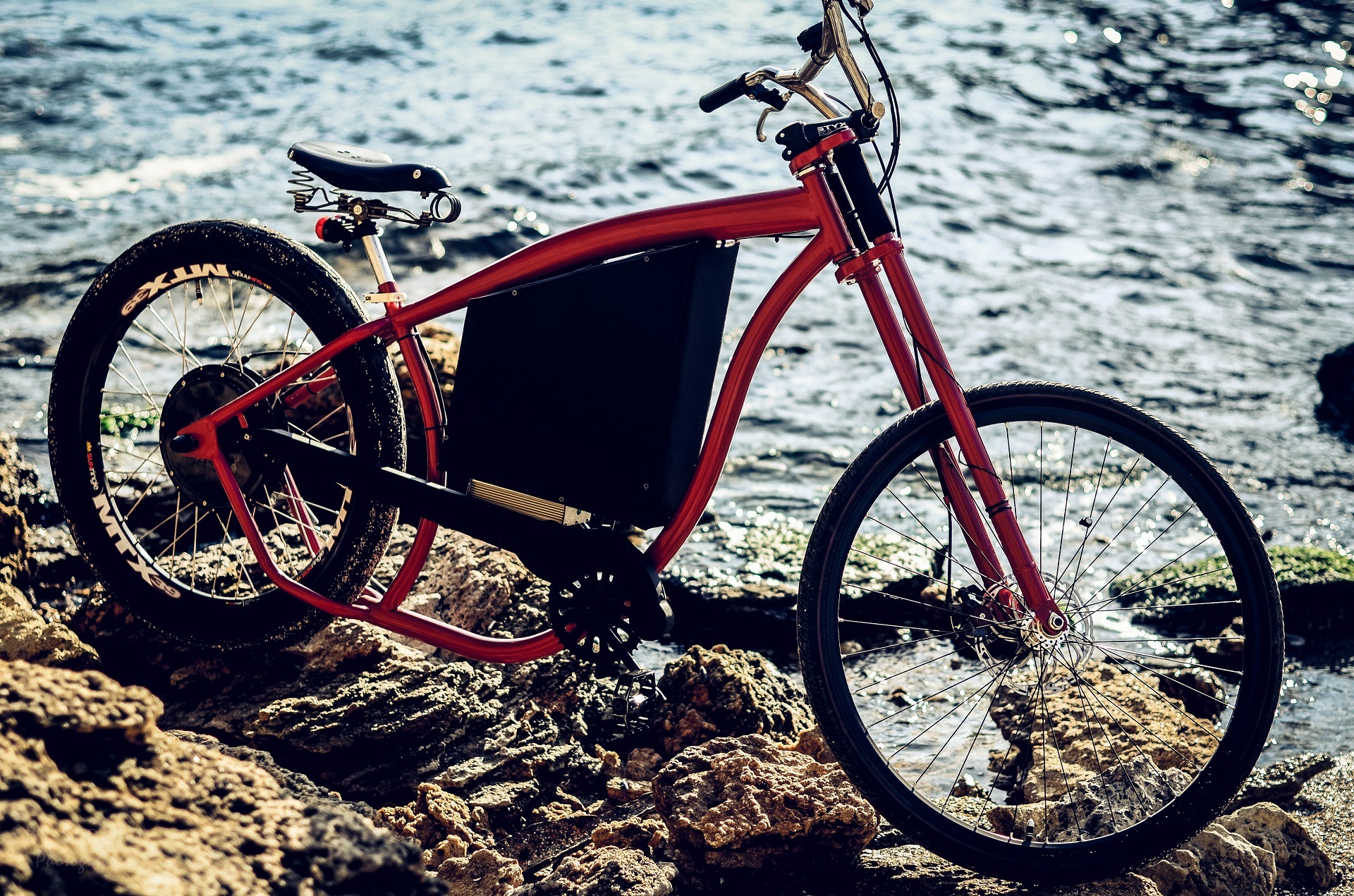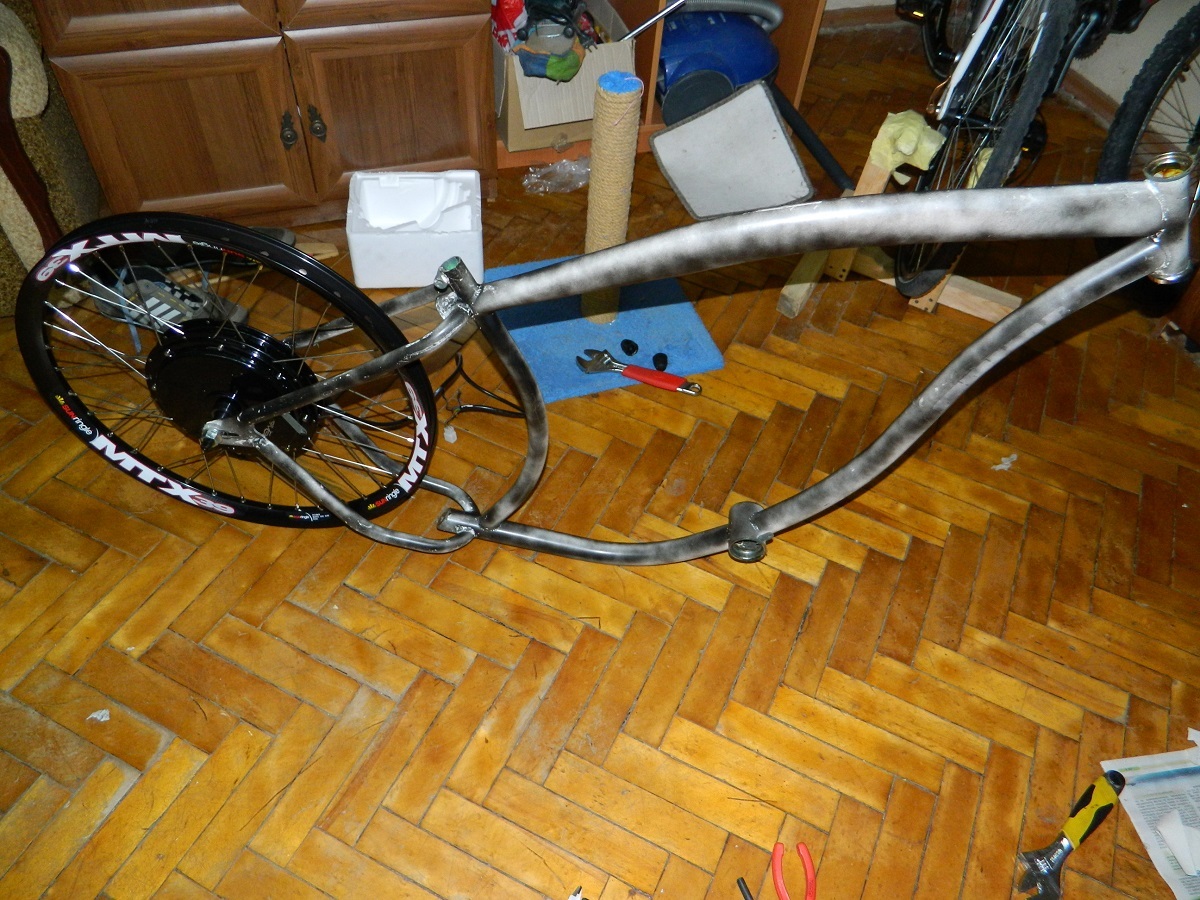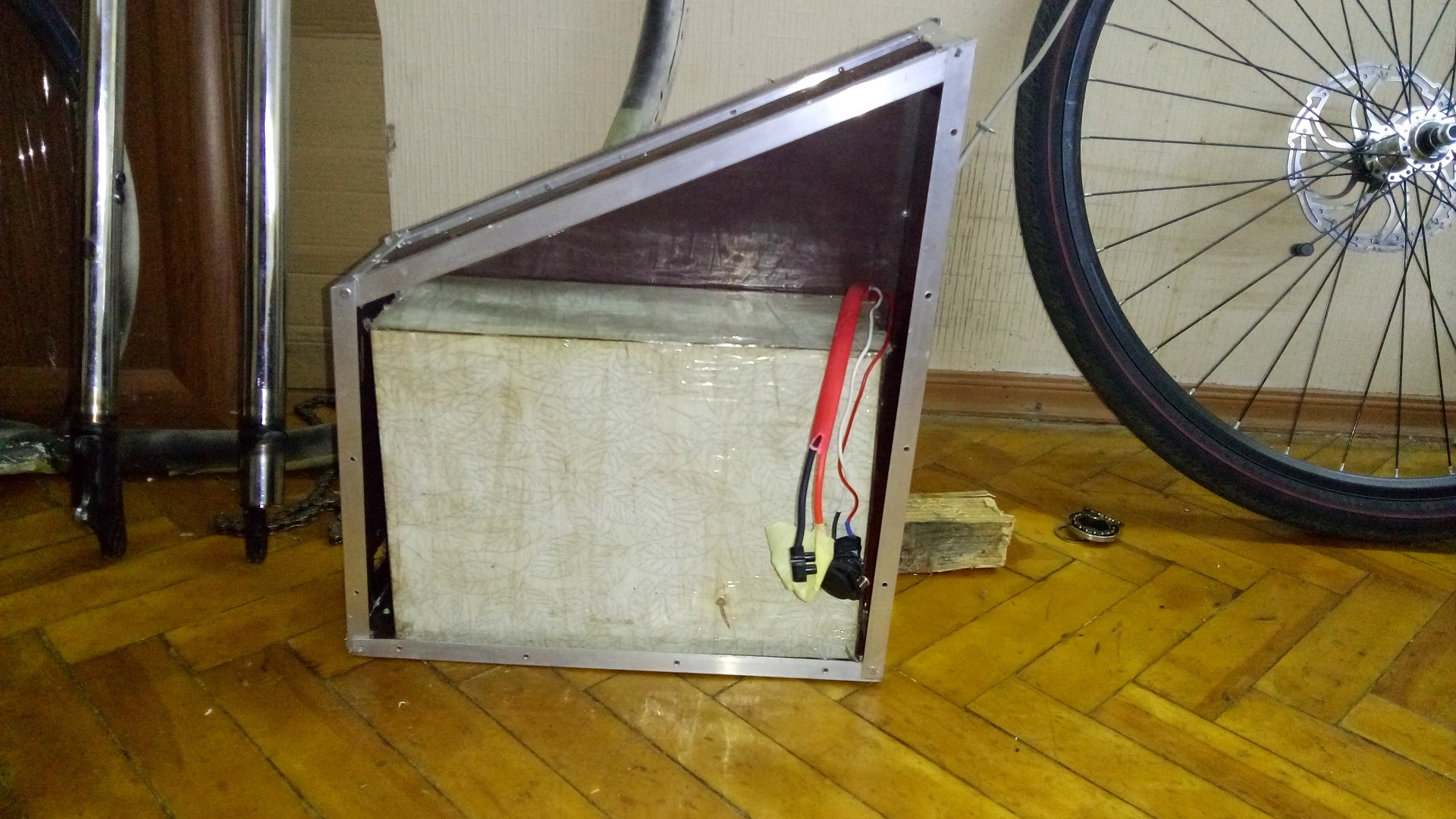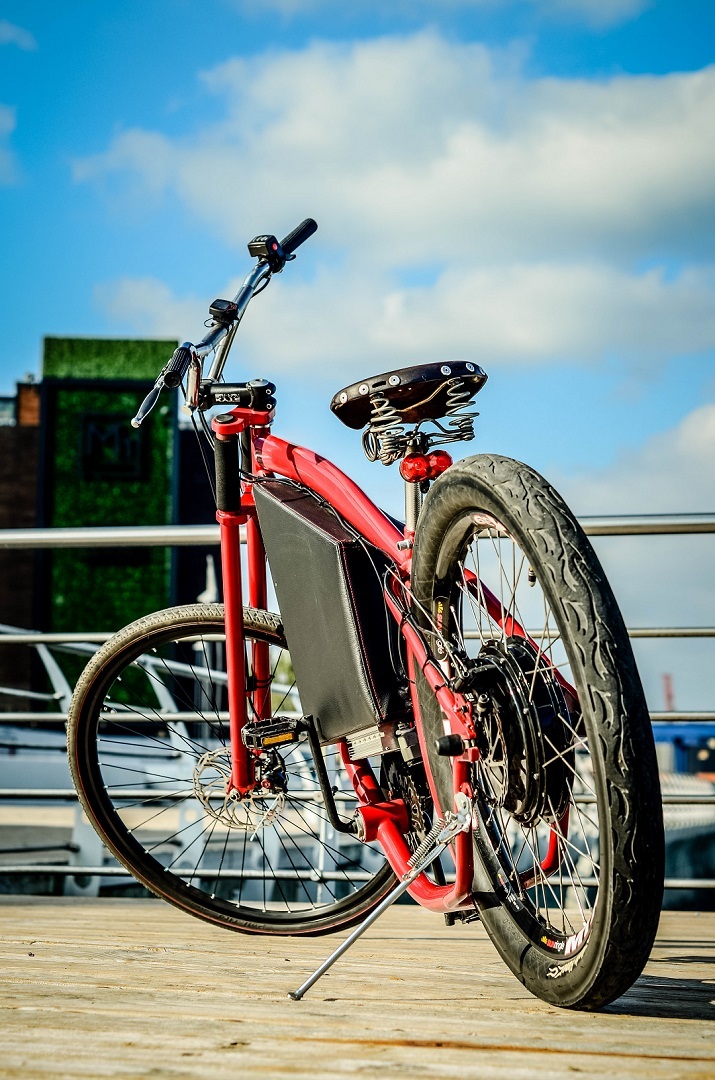How I built a budget electric bike chopper
Electric bike in the style of the chopper. Maximum speed: 56km / h. Power reserve: up to 150km.

I'll start with the background.
')
I love to ride a bike and not only ride, but if possible use this type of transport to move from point A to point B.
In February 2015, I moved to live in Montenegro for a short time, taking my bicycle with me. The city where I lived did not belong to the flatlands: there the road was either down or up. Once again, dying on the rise uphill, I decided that I needed to do something about it. Electric power needed!
Well, we sit down at specialized forums and for a couple of weeks we are studying the essence of the issue. Looking at the custom "shahid bikes" (this led in a pile of wires), I gradually drew a picture of what I wanted.
1. When building to go as far as possible from the "design shahid".
2. Reliability and simplicity.
In general, the choice fell on a gearless wheel motor.
3. Ready spatial frames are nice, but they remind me of motocross bikes, it is convenient, reliable, fast, etc. But, alas, they do not suit me for aesthetic reasons + considerable weight.
4. Regular cross-country is also not exactly what I would like to see.
Thus, the choice fell on something like a chopper or a cruiser. I thought for a long time whether to do it with depreciation or not, in the end I decided that the first project was a trial one, so there is no point in making the frame from scratch (especially since it costs a lot of money), in general, I decided that I would manage to find something.
And so, at the beginning of the summer I returned to Odessa and decided that it was time to start.
After a brief search, the Nirve Cannibal was acquired. Next kilowatt motor-wheel and a standard controller to it. I will make a reservation: first I wanted the MK (motor-wheel) to 3 kW, but I decided that this would be a bit too much.
Fitting:

Preparing the frame: it was necessary to increase the dropouts so that the MK axis did not turn, the benefit of the iron frame didn’t cause any problems, just welded the 8mm plates and turned them around.
The photo is not so hot, but there was no other, in general, the Masisto turned out:

Also had to weld mounting for disc brakes.
After began the search for the battery. Ordering directly from China ready was fraught with the fact that I ran into a poor-quality product, and the price tag there did not say that it was very tasty. In local stores, too, trouble. In general, the search for a solution was delayed for a month or two. But in the end, Li-Pol packages for 38A * h were purchased, and a 48V battery was assembled from them. Having decided to play it safe, I gave the assembly to outsourced children with experience.
The result was a rechargeable battery 48V 38A * h or 1.8 kWh with BMS at 60A * h. 100% charged at 54.6V, controller cuts off at 42V.
The size of one cell is approximately 28cm * 22cm * 0.8cm. When assembling them between the packages, there should be a flat hard dialectician; usually use chipboard, plywood, plastic.
It was originally assembled using chipboard, but the thickness of the finished specimen was not so hot, it was altered with a different gasket (I have no idea what this is and how it is called).
The battery is tried on the case:

Case dimensions:

Now about the case for the battery. A lot of layouts, materials, forms were enumerated. As a result, I stopped at the option from the image above.
Made from aluminum corners 15 * 15 and (sorry for my french) some kind of garbage found on the balcony. The body was reworked several times, as the jambs were in the process. And yes, the box was supposed to be durable, since the weight of the battery in final form is more than 13 kg. The box is mounted on the bolts from the inside, the side wall on the screws (there was an option on neodymium magnets, but it did not meet the expectations). Also, an additional box was covered with stretch film, and leatherette on top. Now with the finished version can be made of fiberglass, if you want feng shui.
After the box was prepared, the frame went for revision and painting, holes were drilled in the frame, nuts were inserted and scalded. Since the lower frame tube is quite close to the road due to the construction, an additional reinforcing plate was welded to it. The protrusions of the upper and lower tubes after the seatpost, on which the wing is attached, were shortened, as they prevented the wheel from standing up more deeply. The frame was painted with powder paint. The layer turned out to be quite decent, it covered the welding places: as the modifications, and factory welding, the seams are almost invisible.
Initially, brake knobs with sensors were installed (when the brake is clamped, the wheel does not turn if you press the gas) But after a small running in, it became clear that, in principle, they are not needed, so the wires from the handles were removed (fewer wires - less “design martyrs”) . In general, on the steering wheel there was only one wire from the gas kurkovoy handle.
Wheels: rear 26 "with 3-inch tire, front 28" 1.75. Brakes - Tektro and Avid BB7 disc mechanics. 180mm wheels. Anterior star on 44 teeth, back on 18.
Coming to the end, I will describe the test races.
The first race was about 25 km, after 17 km the electrician refused: initially suspicion fell on the controller being overheated, as it was originally in the box with the battery, but later it turned out that the packages were badly soldered to each other. Yes, the rest of the way to the house I overcame on the pedals, considering the weight of the bike (45 kg plus or minus), not the best reel (gearless MK has such a feature), not the best ratio of stars and rider landing, I think that everything went more Why is it good.
Later there were tests for 100 km, and they were carried out with the chain removed so as not to spoil the final result. I would like to say that the power reserve strongly depends on driving style, headwind and actually from the road itself. The same distance during the test for 100 km was very different in average speed, although in the first case, in the second case, about 25% of the charge remained in the battery at the end of the race. By the way, charging takes about 3 hours.
It is a pleasure to ride, the landing is very comfortable, you can go for several hours without getting tired.
By cost:
Frame (bike assembly) with modifications and painting: $ 600
Battery with box: $ 600
Motor wheel + rim + controller and every little thing: $ 250
Shipping costs: ~ $ 50
Well, maybe something else on the little things, which I do not remember.
Well, after some more photos:




I'll start with the background.
')
I love to ride a bike and not only ride, but if possible use this type of transport to move from point A to point B.
In February 2015, I moved to live in Montenegro for a short time, taking my bicycle with me. The city where I lived did not belong to the flatlands: there the road was either down or up. Once again, dying on the rise uphill, I decided that I needed to do something about it. Electric power needed!
Well, we sit down at specialized forums and for a couple of weeks we are studying the essence of the issue. Looking at the custom "shahid bikes" (this led in a pile of wires), I gradually drew a picture of what I wanted.
1. When building to go as far as possible from the "design shahid".
2. Reliability and simplicity.
A small explanation: the outboard engine is not simple, in addition, the chain and the stars need to be lubricated and they will wear out, the same is true for the engines that are attached directly to the carriage unit. Although with this approach it is possible to make a transmission, which has a beneficial effect on the dynamics of acceleration and maximum speed, but not for long. Let me explain, because perhaps not everyone is up to date. The two easiest options are the planetary park, but they do not live for a long time from electric motors and fall apart. The usual system, like on many mountain bikes with several (usually 6 or more) asterisks and perekidkoy, but alas, this option was also dropped quickly, because there the chain will wear an average of 1000 km, and the stars will live about 3 thousand, and I am very optimistic.
In general, the choice fell on a gearless wheel motor.
3. Ready spatial frames are nice, but they remind me of motocross bikes, it is convenient, reliable, fast, etc. But, alas, they do not suit me for aesthetic reasons + considerable weight.
4. Regular cross-country is also not exactly what I would like to see.
Thus, the choice fell on something like a chopper or a cruiser. I thought for a long time whether to do it with depreciation or not, in the end I decided that the first project was a trial one, so there is no point in making the frame from scratch (especially since it costs a lot of money), in general, I decided that I would manage to find something.
And so, at the beginning of the summer I returned to Odessa and decided that it was time to start.
After a brief search, the Nirve Cannibal was acquired. Next kilowatt motor-wheel and a standard controller to it. I will make a reservation: first I wanted the MK (motor-wheel) to 3 kW, but I decided that this would be a bit too much.
Fitting:
Preparing the frame: it was necessary to increase the dropouts so that the MK axis did not turn, the benefit of the iron frame didn’t cause any problems, just welded the 8mm plates and turned them around.
The photo is not so hot, but there was no other, in general, the Masisto turned out:

Also had to weld mounting for disc brakes.
After began the search for the battery. Ordering directly from China ready was fraught with the fact that I ran into a poor-quality product, and the price tag there did not say that it was very tasty. In local stores, too, trouble. In general, the search for a solution was delayed for a month or two. But in the end, Li-Pol packages for 38A * h were purchased, and a 48V battery was assembled from them. Having decided to play it safe, I gave the assembly to outsourced children with experience.
The result was a rechargeable battery 48V 38A * h or 1.8 kWh with BMS at 60A * h. 100% charged at 54.6V, controller cuts off at 42V.
The size of one cell is approximately 28cm * 22cm * 0.8cm. When assembling them between the packages, there should be a flat hard dialectician; usually use chipboard, plywood, plastic.
It was originally assembled using chipboard, but the thickness of the finished specimen was not so hot, it was altered with a different gasket (I have no idea what this is and how it is called).
The battery is tried on the case:

Case dimensions:

Now about the case for the battery. A lot of layouts, materials, forms were enumerated. As a result, I stopped at the option from the image above.
Made from aluminum corners 15 * 15 and (sorry for my french) some kind of garbage found on the balcony. The body was reworked several times, as the jambs were in the process. And yes, the box was supposed to be durable, since the weight of the battery in final form is more than 13 kg. The box is mounted on the bolts from the inside, the side wall on the screws (there was an option on neodymium magnets, but it did not meet the expectations). Also, an additional box was covered with stretch film, and leatherette on top. Now with the finished version can be made of fiberglass, if you want feng shui.
After the box was prepared, the frame went for revision and painting, holes were drilled in the frame, nuts were inserted and scalded. Since the lower frame tube is quite close to the road due to the construction, an additional reinforcing plate was welded to it. The protrusions of the upper and lower tubes after the seatpost, on which the wing is attached, were shortened, as they prevented the wheel from standing up more deeply. The frame was painted with powder paint. The layer turned out to be quite decent, it covered the welding places: as the modifications, and factory welding, the seams are almost invisible.
Initially, brake knobs with sensors were installed (when the brake is clamped, the wheel does not turn if you press the gas) But after a small running in, it became clear that, in principle, they are not needed, so the wires from the handles were removed (fewer wires - less “design martyrs”) . In general, on the steering wheel there was only one wire from the gas kurkovoy handle.
Wheels: rear 26 "with 3-inch tire, front 28" 1.75. Brakes - Tektro and Avid BB7 disc mechanics. 180mm wheels. Anterior star on 44 teeth, back on 18.
Coming to the end, I will describe the test races.
The first race was about 25 km, after 17 km the electrician refused: initially suspicion fell on the controller being overheated, as it was originally in the box with the battery, but later it turned out that the packages were badly soldered to each other. Yes, the rest of the way to the house I overcame on the pedals, considering the weight of the bike (45 kg plus or minus), not the best reel (gearless MK has such a feature), not the best ratio of stars and rider landing, I think that everything went more Why is it good.
Later there were tests for 100 km, and they were carried out with the chain removed so as not to spoil the final result. I would like to say that the power reserve strongly depends on driving style, headwind and actually from the road itself. The same distance during the test for 100 km was very different in average speed, although in the first case, in the second case, about 25% of the charge remained in the battery at the end of the race. By the way, charging takes about 3 hours.
It is a pleasure to ride, the landing is very comfortable, you can go for several hours without getting tired.
By cost:
Frame (bike assembly) with modifications and painting: $ 600
Battery with box: $ 600
Motor wheel + rim + controller and every little thing: $ 250
Shipping costs: ~ $ 50
Well, maybe something else on the little things, which I do not remember.
Well, after some more photos:



Source: https://habr.com/ru/post/369119/
All Articles